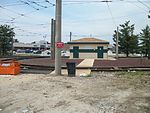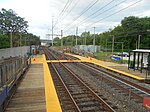National Airlines Flight 83
Accidents and incidents involving the Douglas DC-4Airliner accidents and incidents involving runway overrunsAviation accidents and incidents in the United States in 1951National Airlines (1934–1980) accidents and incidentsPhiladelphia International Airport

National Airlines Flight 83 was a United States domestic flight from Newark International Airport, serving New York City, to Philadelphia. On January 14, 1951, the Douglas DC-4 of National Airlines crashed on landing at Philadelphia International Airport. The aircraft over-shot the runway, ran into a ditch and caught fire. Of the 28 people on board, 7 were killed and 11 injured. One of the dead was the lone flight attendant, Frankie Housley, who had gone back into the burning aircraft to try to save more passengers.
Excerpt from the Wikipedia article National Airlines Flight 83 (License: CC BY-SA 3.0, Authors, Images).National Airlines Flight 83
Darby Creek Trail, Tinicum Township
Geographical coordinates (GPS) Address Website Nearby Places Show on map
Geographical coordinates (GPS)
| Latitude | Longitude |
|---|---|
| N 39.872269444444 ° | E -75.237469444444 ° |
Address
Philadelphia International Airport
Darby Creek Trail
19113 Tinicum Township
Pennsylvania, United States
Open on Google Maps






